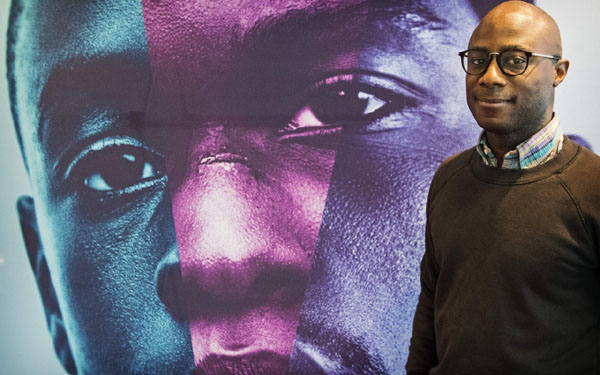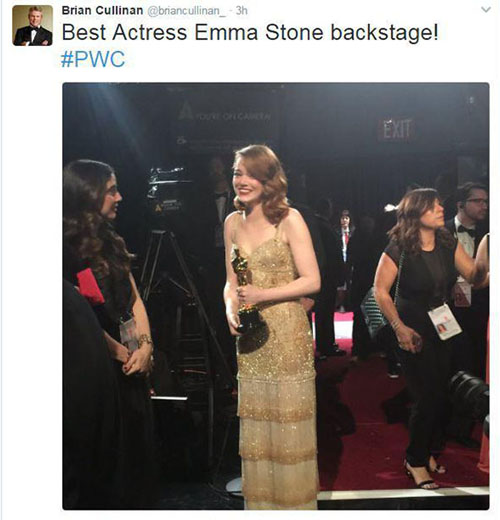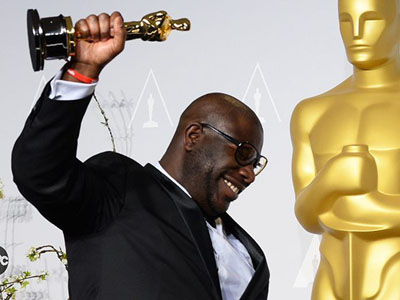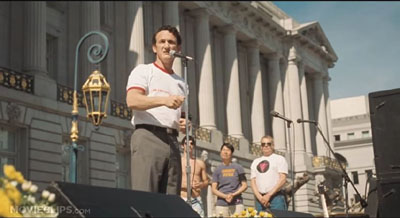The Oscars’ Best Picture and other Best Picture
Tuesday | March 7, 2017 open printable version
open printable version
Barry Jenkins
Kristin here:
No, I’m not referring to the mistake that led to two different titles being read out as Best Picture recipients in the chaotic final minutes of this year’s broadcast of the Academy Awards. That error has drawn huge amounts of attention from the media. But other more interesting aspects of the pattern of winners have been largely ignored.
The explanation for the mess-up has turned out to be that there are two duplicate stacks of those sealed and highly guarded envelopes, one on either side of the stage, so that presenters can be handed whichever envelope they are supposed to have, with the duplicate one on the other side being discarded. Apparently one of the PwC (formerly known as PricewaterhouseCooper) partners was so gobsmacked by seeing Emma Stone backstage at the ceremony that he was more concerned to tweet a photo of her than to make sure that the duplicate envelope for her category got removed from the stack on the side of the stage he was tending. Still being atop the stack, it ended up being given to Warren Beatty and Faye Dunaway, who were to announce the Best Picture winner.
This image is deleted but not forgotten.
Well, there’s a simple remedy for the problem. Have all the presenters enter from the same side (the winners all exit toward the same side, after all) and have just one set of envelopes with two people keeping track of them in case one gets starstruck.
Beyond the kerfuffle
But more interesting to me was the rather odd imbalance in the awards for the top winners. La La Land was widely expected to garner Best Picture, and it won in six of its potential thirteen categories. (Two of its songs were nominated and competing against each other, so the film could not have won on all fourteen nominations.) Those included some pretty important categories: Best Actress, Director, Cinematography, Score, Song, and Production Design. Moonlight won three out of its eight nominations: Best Picture, Supporting Actor, and Adapted Script.
It seemed to me that we have seen other similar results in recent years, and the reason is clearly political. For decades the assumption was the the Academy consisted of members of the filmmaking profession awarding each other statuettes on the basis of technical and artistic excellence. Aesthetic criteria ruled, though the middlebrow tastes of a lot of the Academy members tended to fasten on quite conventional sorts of mainstream films.
The movies that won Best Picture were typically serious items made by the big studios. Historical epics (Gladiator, Titanic), biopics (A Beautiful Mind), dramas (The English Patient, American Beauty), auteur pictures (No Country for Old Men, The Departed), and the occasional relatively lightweight item somehow steamrollered through by Harvey Weinstein (Shakespeare in Love, The King’s Speech). Genre films might get nominated but they seldom won. The Lord of the Rings astonished fans by actually receiving seventeen Oscars over three annual parts, including Best Picture for The Return of the King.
Most of the nominated films were noted neither for their diversity of characters and cast nor for their progressive politics.
In recent years, however, the political implications of filmmaking and the Oscars have become far more high-profile. The country has paid the price for electing its first black president by witnessing the surfacing of a racist backlash so extreme that few would have believed it possible. The shooting of Michael Brown by police in Ferguson, Missouri in 2014 and the events that followed called attention to a blight that has stayed with us, the needless killing of black men and boys and women, with the officers involved seldom being charged with any crime. The hugely unfair incarceration rate of black people. The horrendous rise in attacks against virtually any non-white, non-Christian group in this country unleashed by the “election” of T***p. And the concealment of widespread domestic terrorism, which in body counts (including those of peace officers) far outweigh the purported threats from the Middle East.
The result, I think, is a greater consciousness of political content, and specifically progressive content, among the Academy members. Three times in the past four Oscar presentations, there have in a sense been two winners. One film is judged more on the technical and artistic grounds and given a larger number of awards but not Best Picture. Another film with an important political theme at its core receives a distinctly smaller number, including Best Picture. The practice seems to imply that the voters want to give the top award to two films, and they have somehow collectively found a way to do so.
Three recent examples
The first of the three split decisions was for the 2013 releases, when Gravity was up against 12 Years a Slave. Despite being in the science-fiction genre, Gravity (here and here) was so innovative and sophisticated in the technology that created such a perfect illusion of outer space that it won seven of the ten categories in which it was nominated. These were Director, Cinematography, Editing, Score, Sound Editing, Sound Mixing, and Visual Effects.
12 Years a Slave, made by an established and respected black director, Steve McQueen (above with his producer’s Oscar), was nominated for eight Oscars and took three: Best Picture, Adapted Screenplay, and Supporting Actress, for Lupita Nyong’o. The implication seemed clear. A film could be best because it was so well made or best because its content was so politically important. Which is not to say that a single film could not be both, and that may well happen.
It’s also not to say that 12 Years a Slave and the other politically oriented films I mention in this entry are not well made. Any film that achieves the rarefied heights of Oscar nominations is likely to be very well made. The politically daring films, however, tend to be indies with relatively small budgets and hence less access to complex technology and fancy sets and costumes. The big studios that do have such access are not exactly noted for the daring ideology of their releases. (The recent fuss over the fact that a Disney film, the upcoming live-action Beauty and the Beast, has a gay character in it is testimony to that.)
The same thing did not happen in 2014, when Birdman won Best Picture, as well as Director (for a Latino, Alejandro Iñárritu), Original Screenplay, and Cinematography. The main politically oriented film nominated for Best Picture was Ava DuVernay’s Selma, which won only in its one other category, Best Song. One might also want to put The Imitation Game, with its gay protagonist, into the political category. It was nominated in eight categories, winning only Adapted Screenplay. This was the year when the paucity of black nominees led BroadwayBlack.com managing editor April Reign to launch #OscarsSoWhite. The protest and its hashtag became more prominent in response to the lack of African American nominees from 2015 films. The Academy responded with some changes to its membership and rules.
The 2015 Oscars made the divide between the two “best pictures” clearer. The action film Mad Max: Fury Road was both widely praised and popular, and surprisingly enough, it won in six of its ten nominated categories. These were Costumes, Editing, Makeup/Hairstyling, Production Design, Sound Editing and Sound Mixing. It lost Best Picture, Director, Cinematography, and Special Effects.
Spotlight, with its focus on sexual abuse by Catholic priests, was nominated for six Oscars and won only two: Best Picture and, as inevitably happens in the cases of political films, Original Screenplay. It lost Director, Supporting Actor, Supporting Actress, and Film Editing. With a genre film and a political one both rewarded, the Academy also honored a more traditional prestigious drama and gave The Revenant Best Director, Actor, and Cinematography.
Then came Moonlight in 2016, with its combination of black and gay subject matter, to broaden the Oscars’ horizons even further. (The other film directed by a black actor, Denzel Washington, who was not nominated in that category, won Best Supporting Actress for Viola Davis.)
How did we get here?
This pattern is not entirely new. It’s just happening more frequently and obviously. It has been creeping up on us for a little over a decade now. The prominence of a politically based set of awards began to emerge, I suspect, in 2005 with Brokeback Mountain (bottom). It received eight nominations, including Best Picture, and won Director, Score, and Adapted Screenplay. It was widely perceived to have lost the top award to Crash because of opposition to its gay subject matter. Crash, which dealt with race relations in a way that divided critics and audiences, won Best Picture, Original Screenplay, and Film Editing.
To some extent Juno, nominated in 2007 for Best Picture, Original Screenplay (its only win), and Actress, fits into the political pattern, with its focus on abortion. It straddled the liberal line, with the heroine deciding against abortion but the film treating this as a matter of choice. No Country for Old Men won Best Picture as well as three other awards among its eight nominations: Director, Adapted Screenplay, and Supporting Actor (a Spanish actor, Javier Bardem playing a character who might be Mexican).
The political nominee in 2008 was Milk (above), with its sympathetic gay theme. Of its eight nominations, it won Best Original Screenplay and Actor. By then the association of a best-screenplay award with a liberal (or semi-liberal) film was firmly in place. Slumdog Millionaire took Best Picture and eight other Oscars.
2009 was the year when the Academy extended the Best Picture category to a potential ten, the idea being to boost the ratings of the television broadcast of the awards ceremony. Supposedly, now blockbusters would be nominated alongside the more prestigious dramas, biopics, and indie breakout films. (In practice, only 2009 and 2010 saw ten nominations. There were nine in 2011, 2012, 2013, and 2016, and eight in 2014 and 2015.) To some extent that plan worked, with Avatar gaining a nomination. There was also room for animated films, with Up being nominated in both Best Picture and Animated Feature categories (as Toy Story 3 was in 2010).
But as one would expect, small indie films, some of them politically oriented, filled out the list. One of them, The Hurt Locker, had grossed just under $50 million worldwide, compared with Avatar‘s nearly $2.8 billion (still the highest-grossing film of all time). The Hurt Locker was an anti-war film, but the main political punch to the broadcast was the question of whether Kathryn Bigelow would become the first female director of a Best Picture winner–with the added spice of her most obvious competitor, James Cameron, being her ex-husband. She did.
That same year, however, another film more closely fitting the political pattern was nominated: Precious, with six nominations including Best Picture. It was the first of these socially-conscious films to deal primarily with African American characters, and although it did not win Best Picture, it received the by-then-familiar consolation prizes of Best Adapted Screenplay and Supporting Actress (with a standing ovation for Mo’Nique when she took the stage to pick up her Oscar). Would Precious have been nominated for Best Picture without the newly capacious category? It’s anyone’s guess.
The pattern did not continue for the next few years. The Kids Are All Right, with its lesbian central couple, was the closest that the 2010 Best Picture nominees had to a political contender. It was nominated for the established categories: Best Picture, Original Screenplay, Supporting Actor, and Supporting Actress. It won none of them. 2011 saw The Help, with a mixed black and white cast, get nominated for Best Picture, as well as Actress (Viola Davis’ first nomination) and two competing Supporting Actress nods (Octavia Spencer won the film’s only Oscar over Jessica Chastain). Harvey Weinstein again triumphed with The Artist, which won Best Picture, as well as Director, Actor, Costume, and Original Score of its original ten nominations.
For 2012, two black-themed films were nominated for Best Picture. Beasts of the Southern Wild garnered three additional nominations with no wins: Director, Original Screenplay, and Actress. Django Unchained got four other nominations, winning Original Screenplay and Supporting Actor. Argo won Best Picture, Adapted Screenplay, and Film Editing out of its seven nominations.
Then 2013 brought the win for 12 Years a Slave.
Perhaps it’s just a coincidence that in recent years we have seen three politically daring films win Best Picture while only gaining one or two other awards. As with political films from Brokeback Mountain on, those awards tend to include one for the screenplay, adapted or original, as if the voters are trying to emphasize that the film is important primarily because of its subject. There is usually an acting award as well, more often in a supporting role. Interestingly Hidden Figures, which didn’t win any Oscars, was nominated in those same three categories: Best Picture, Adapted Screenplay, and Supporting Actress.
Will Academy voters continue delicately dividing the awards in order to stress the importance of two films? The tactic tends to give a bunch of awards to a very popular film and a few–including the most prestigious one–to a film that the voters are in effect encouraging more people to see. There’s something to be said for doing so.
Politics and the foreign-language Oscar
For a long time it was assumed that this year the German comedy Toni Erdmann had this category sewn up. Then, T***p signed his first anti-Muslim immigration ban just a few days after the Oscar nominations were announced. Iranian director Asghar Farhadi’s The Salesman was in the list of foreign-language nominees. (He had previously won in the same category for A Separation in 2011.) Farhadi announced that in protest of the ban, and probably through legitimate concerns that he would not be admitted to the country, he would not attend the Academy’s ceremony. Speculation began to circulate that Academy members might vote for his film in solidarity. The Salesman won the Oscar, though to what extent this was a move by those members against the ban is unclear. I personally enjoyed and admired Toni Erdmann, but I consider The Salesman a better film.
As film critic Bilge Ebiri has pointed out, strongly political foreign films have not typically won in this category. Still, voting rules have changed:
Academy members get screeners in the mail, and they need not prove that they’ve seen all, or in fact any, of the nominees before they send their ballots. That could mean a surge of people voting for The Salesman simply because they’re looking to stick it to Trump.
But there might be more far-reaching implications for a Farhadi win. The Muslim world has undergone a filmmaking renaissance in recent decades. Much of this began with the work of Iranian directors in the 1980s and ’90s, but it has since expanded to the rest of the Middle East and North Africa. For many years, Oscar failed to recognize these works. Abbas Kiarostami, who died in July, was the most important figure of the New Iranian Cinema and an undisputed giant of international film but notably was never nominated.
Slowly, however, the Academy has been noticing. Last year, Turkish director Deniz Gamze Erguven’s Mustang, about the plight of young women in Turkey, was a nominee (albeit as a French submission) alongside Jordanian director Naji Abu Nowar’s gripping World War I drama Theeb. During the past decade, directors including Palestine’s Abu-Assad and Algeria’s Rachid Bouchareb have vied for statuettes multiple times. And the more visible people are, the harder they become to demonize.
In that sense, a win for Farhadi would mean more than just a repudiation of a specific presidential decree. It would help to push further into the spotlight a cultural revolution that has been happening for years now. In doing so, it would be the ultimate assertion of a people’s humanity. And sadly, we now live in a world where that indeed is a political act.
The fact that for a time Iran had one of the most exciting national cinemas in the world has remained largely overlooked, even by many admirers of foreign cinema. I don’t have much hope that that tradition and the more recent films of directors like Farhadi and Jafar Panahi will become widely known. Still, some people will take note. Watching the great Iranian films of the past few decades would reveal the humane, touching stories that their makers tell–and watching Middle Eastern films in general could, as Ebiri says, remove the knee-jerk demonizing of people from that region. After all, the vast majority of Muslims fear and hate the extremists and terrorists as much as anyone else does.
The Oscars are not all that important in the larger scheme of things. In recent years they have been increasingly hyped, and media chatter about them has become a year-round phenomenon that drives out a lot of serious news about the film industry. (It’s cheaper to have an employee watch some films and go on and on about their Oscar prospects than to finance them going out and reporting on things.) Only the naive think that the actual best films made in the world in any given year get the Oscars.
But clearly the Oscars do matter to people who are trying to use them as a tool to pressure the industry into introducing more diversity into the kinds of subjects that provide stories and into the range of people who work in front of and behind Hollywood’s cameras. It seems to be affecting the industry to some extent, at least for African Americans. Now, can it work for other under-represented groups? For discussions of that question, see Variety‘s post-Oscars coverage here and here.
March 13: Thanks for Ivan Nunes for a factual correction.
Brokeback Mountain



















